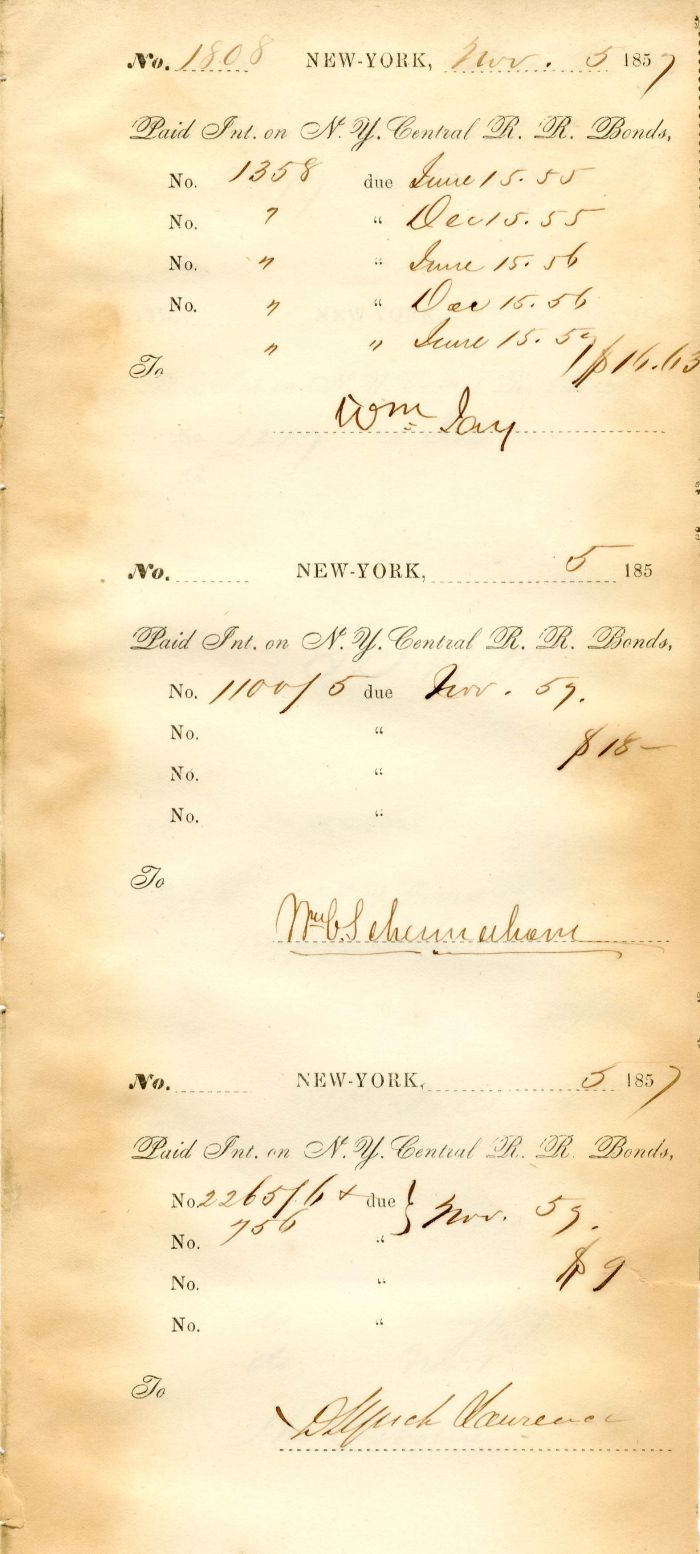N.Y. Central R.R. Bond stubs signed by William Schermerhorn and William Jay
Inv# AG1989A Bond
Stub of Bond for N.Y. Central R.R. Company signed by Wm. Schermerhorn and Wm. Jay.

William Colford Schermerhorn (June 22, 1821 – January 1, 1903) was an American lawyer, philanthropist, and patron of the arts. Schermerhorn was born in New York City on June 22, 1821. He was the son of Peter Schermerhorn (1781–1852) and Sarah (née Jones) Schermerhorn (1782–1845).[2] Among his siblings was older brothers John Jones Schermerhorn (who married a daughter of Mayor Philip Hone), Peter Augustus Schermerhorn (who married Adaline Emily Coster), and Edmund H. H. Schermerhorn. His paternal grandparents were Elizabeth (née Bussing) Schermerhorn and Peter Schermerhorn, a wealthy New York City merchant and land owner known as "Peter the Elder". Among his extended family was uncle Abraham Schermerhorn, the father of Caroline Schermerhorn Astor, who married William Backhouse Astor Jr. and became the leader of "The Four Hundred." On his mother's side, he was the grandson of John Jones and Eleanor (née Colford) Jones of Jones's Wood. His maternal uncle, Gen. James I. Jones, married his paternal cousin, Elizabeth Schermerhorn (Abraham's daughter and Caroline's sister). James and Elizabeth were the parents of Eleanor Colford Jones, who married Augustus Newbold Morris. Schermerhorn was educated in private schools in New York before attending Columbia College, where he graduated with honors in 1840 (alongside Robert Lenox Kennedy and Ogden Hoffman Jr.). Later, in 1860, Columbia awarded him an honorary A.M. degree and he was made a trustee of the college.

William Jay (June 16, 1789 – October 14, 1858) was an American reformer, jurist, and the son of Founding Father and first U.S. Supreme Court Chief Justice John Jay. Jay was born in New York City on June 16, 1789, in between his father's terms as United States Secretary of Foreign Affairs in the administration of George Washington. He was the son of John Jay (1745–1829) and Sarah Van Burgh (née Livingston) Jay (1756–1802). Among his older siblings was Peter Augustus (who served as Recorder of New York City under Richard Riker), Susan, Maria, and Ann Jay. His maternal grandparents were Susannah (née French) Livingston and William Livingston, an attorney who was a signer of the United States Constitution and later served as the first post-colonial Governor of New Jersey during the American Revolutionary War. His paternal grandparents were Peter Jay, a wealthy trader in furs, wheat, timber, and other commodities, and Mary (née Van Cortlandt) Jay (daughter of New York mayor Jacobus Van Cortlandt). He graduated from Yale College in 1808. After his graduation, he took up the management of his father's large estate in Westchester County, New York, and also studied law at Albany. Poor eyesight soon compelled him to give up the legal profession. He early became interested in various philanthropic enterprises and reforms and identified himself especially with the temperance, antislavery, and antiwar movements. He was one of the founders (in 1816) of the American Bible Society, which he defended against the vigorous attacks of the High Church party, led by Bishop Hobart. He was judge of common pleas in New York from 1818 to 1820, and was first judge of Westchester County from 1820 to 1842, when he was removed on account of his anti-slavery views. An enthusiastic member of the American Antislavery Society, whose constitution he drafted, Jay stood with Birney at the head of the conservative abolitionists, and by his calm, logical, and judicial writings exerted for many years a powerful influence. From 1835 to 1837 he was the society's corresponding foreign secretary. In 1840, however, when the society began to advocate measures which he deemed too radical, he withdrew his membership, but with his pen he continued his labor on behalf of the slave, urging emancipation in the District of Columbia and the exclusion of slavery from the territories, though deprecating any attempt to interfere with slavery in the states. He was also a proponent of antiwar theories and was for many years president of the Peace Society. His pamphlet War and Peace: the Evils of the First with a Plan for Securing the Last, advocating international arbitration, was published by the English Peace Society in 1842, and is said to have contributed to the promulgation, by the powers signing the Treaty of Paris in 1856, of a protocol expressing the wish that nations, before resorting to arms, should have recourse to the good offices of a friendly power.
A bond is a document of title for a loan. Bonds are issued, not only by businesses, but also by national, state or city governments, or other public bodies, or sometimes by individuals. Bonds are a loan to the company or other body. They are normally repayable within a stated period of time. Bonds earn interest at a fixed rate, which must usually be paid by the undertaking regardless of its financial results. A bondholder is a creditor of the undertaking.










Ebay ID: labarre_galleries